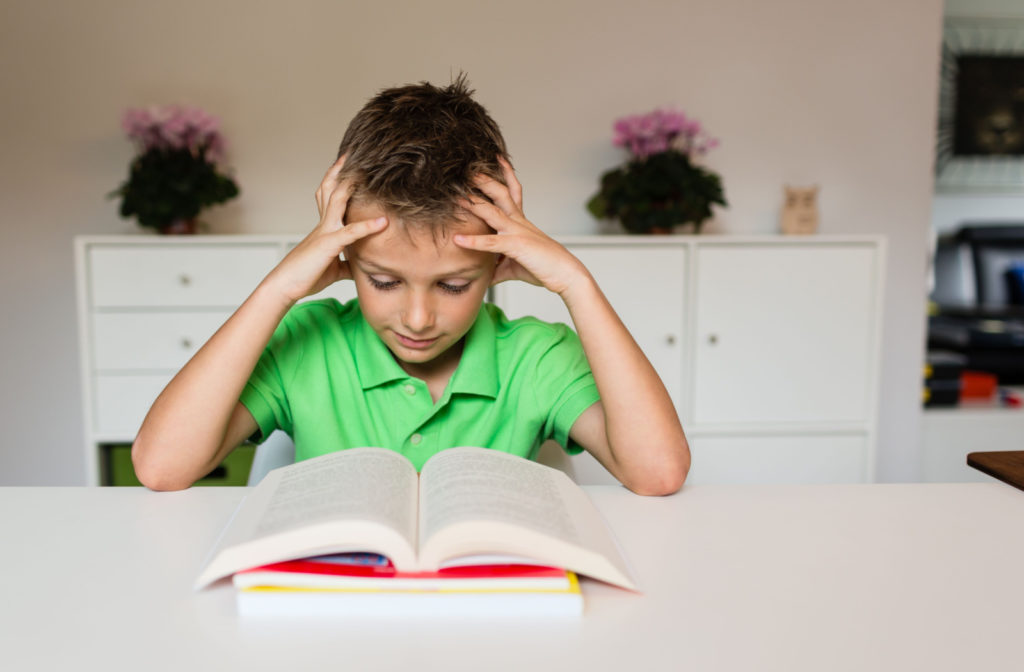If your child is having reading difficulties, it’s possible it could be a sign of a vision problem. Many parents are surprised to learn that the two can be linked.
Kids with vision problems often struggle with reading. Reading requires the ability to see and interpret written words clearly. If a child has a vision issue such as nearsightedness, farsightedness, or astigmatism, they might find it difficult to focus on the text, leading to challenges in understanding it. Moreover, they might avoid reading altogether because it strains their eyes.
Understanding the link between reading difficulties and vision problems is vital for parents, caregivers, and educators. Timely identification and intervention can significantly enhance a child’s learning journey and overall well-being.
Common Vision Problems in Children
Reading difficulties in children are more common than many realize. Two-thirds of kids in the United States struggle with reading, and this struggle can persist into adulthood if not addressed early.
Children can experience various vision problems, including:
- Nearsightedness (myopia): Difficulty seeing objects clearly at a distance, leading to blurry vision when looking at something far away
- Farsightedness (hyperopia): Difficulty seeing objects up close, leading to blurred vision when attempting to read or see objects nearby
- Astigmatism: Irregular curvature of the cornea, leading to blurry or distorted vision at all distances
- Amblyopia (lazy eye): Reduced vision in 1 or both eyes due to a breakdown of communication between the eye and brain
These conditions can be hereditary, but they can also develop as a result of environmental factors such as excessive screen time and lack of time spent outdoors. Regular eye exams are crucial for detecting issues early on and preventing them from significantly affecting a child’s vision.
How Vision Problems Affect Reading Abilities
Vision problems can directly influence a child’s reading abilities. Children with vision issues may struggle with the following:
- Tracking: Difficulty following a line of text, leading to skipping lines or losing place while reading
- Focus: Difficulty maintaining focus on words and sentences, causing frequent breaks and loss of comprehension
- Visual Memory: Difficulty remembering visual information, such as letters and shapes, making it challenging to recognize words and comprehend what is being read
- Eye Teaming: Difficulty coordinating both eyes to work together, leading to double or blurry vision
These challenges can make reading a frustrating and exhausting task for children, affecting their confidence and motivation to read. It may also result in them falling behind academically if they are unable to keep up with their peers.

Addressing Vision Problems Early
Early detection and treatment of vision problems can be crucial for a child’s overall development, particularly their reading abilities. Parents should schedule regular eye exams for their children, especially if they have a family history of vision issues.
Vision correction and treatment for kids may involve:
- Prescription glasses or contact lenses to correct nearsightedness, farsightedness, or astigmatism
- Vision therapy to improve eye teaming and tracking abilities
- Eye exercises and activities recommended by an optometrist to strengthen visual skills
It’s also vital for parents and teachers to be aware of the signs of vision problems in children. These may include:
- Squinting or covering 1 eye while reading
- Complaining of headaches, eye strain, or fatigue while reading
- Losing their place while reading or using a finger to guide them
- Poor spelling and handwriting skills
By addressing vision problems early on, children can develop the necessary visual skills for reading and improve their overall academic performance. It can also help boost their motivation to learn.
Helping Children Maintain Healthy Vision
Aside from addressing existing vision problems, parents can also take steps to maintain their child’s visual health. These include:
- Encouraging regular breaks from screen time and outdoor activities to reduce eye strain
- Providing a well-balanced diet rich in vitamins and minerals that support eye health, such as vitamins A, C, E, and omega-3 fatty acids
- Making sure their child’s environment is well-lit and free from glare
- Teaching good eye hygiene, such as washing hands before touching the eyes and avoiding sharing personal items like towels and makeup
- Educating children on the importance of proper posture while reading and using electronic devices to prevent back and neck strain
Parents should also be aware of the impact of environmental factors on their child’s vision health. This includes exposure to harmful UV rays, which can increase the risk of developing cataracts and other eye conditions later in life.
Comprehensive Eye Care for Children at Total Vision
Maintaining good visual health in children is crucial for their overall well-being and academic success. By addressing any existing issues, providing a healthy lifestyle and environment, and scheduling regular eye exams, parents can help ensure their child’s eyes are well taken care of.
At Total Vision Tierrasanta, we are committed to providing comprehensive eye care for every member of your family. Our team of experienced optometrists offers a range of services, including eye exams, contact lens fittings, and vision therapy. Contact us today to schedule an appointment and take the necessary steps toward maintaining your child’s eye health.


